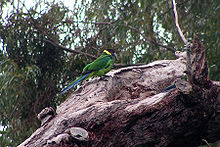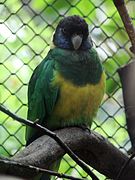- Australian Ringneck
-
For the tropical parakeet species, see Ringnecked Parakeet.
Australian Ringneck 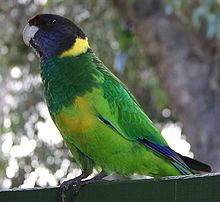
Intermediate between B. z. zonarius and B. z. semitorquatus near Augusta, Western Australia Conservation status Scientific classification Kingdom: Animalia Phylum: Chordata Class: Aves Order: Psittaciformes Family: Psittacidae Subfamily: Platycercinae Tribe: Platycercini Genus: Barnardius
Bonaparte, 1854Species: B. zonarius Binomial name Barnardius zonarius
(Shaw, 1805)Subspecies See text B. z. zonarius
B. z. semitorquatus
B. z. barnardi
B. z. macgillivrayiSynonyms The Australian Ringneck (Barnardius zonarius) is a parrot native to Australia. Except for extreme tropical and highland areas, the species has adapted to all conditions. Traditionally, two species were recognised in the genus Barnardius, the Port Lincoln Parrot (Barnardius zonarius) and the Mallee Ringneck (Barnardius barnardi),[2] but the two species readily interbred at the contact zone and are now considered one species.[3][4] Currently, four subspecies are recognised, each with a distinct range.
In Western Australia, the Ringneck competes for nesting space with the Rainbow Lorikeet, an introduced species. To protect the Ringneck, culls of the lorikeet are sanctioned by authorities in this region. Overall, though, the Ringneck is not a threatened species.
Contents
Description
The subspecies of the Australian Ringneck differ considerably in colouration.[2] It is a medium size species around 33 cm (11 in) long. The basic colour is green, and all four subspecies have the characteristic yellow ring around the hindneck; wings and tail are a mixture of green and blue.
The B. z. zonarius and B. z. semitorquatus subspecies have a dull black head; back, rump and wings are brilliant green; throat and breast bluish-green. The difference between these two subspecies is that B. z. zonarius has a yellow abdomen while B. z. semitorquatus has a green abdomen; the latter has also a prominent crimson frontal band that the former lacks (the intermediate shown in the box has characteristics of both subspecies).[5] The two other subspecies differ from these subspecies by the bright green crown and nape and blush cheek-patches. The underparts of B. z. barnardi are turquoise-green with an irregular orange-yellow band across the abdomen; the back and mantle are deep blackish-blue and this subspecies has a prominent red frontal band. The B. z. macgillivrayi is generally pale green, with no red frontal band, and a wide uniform pale yellow band across the abdomen.[5]
The calls of the Mallee Ringneck and Cloncurry Parrot have been described as "ringing",[5] and the calls of the Port Lincoln Ringneck and Twenty-eight have been described as "strident".[5] The name of the Twenty-eight Parrot is an onomatopoeic derived from its distinctive 'twentee-eight' call.
Taxonomy and naming
The Australian Ringneck was first described by the English naturalist George Shaw in 1805. It is a Broad-tailed parrot and related to the rosellas of the genus Platycercus; it has been placed in that genus by some authorities, including Ferdinand Bauer.[6]
Currently, four subspecies of Ringneck are recognised, all of which have been described as distinct species in the past:[4][7] (As of 1993, the Twenty-eight and Conclurry Parrot were treated as subspecies of the Port Lincoln Parrot and the Mallee Ringneck, respectively).[5]
The classification of this species is still debated, and recent molecular research has found that all subspecies are very closely related.[4] Several other subspecies have been described, but are considered synonyms with one of the above subspecies. B. z. occidentalis has been synomised with B. z. zonarius.[8] Intermediates exist between all subspecies except for between B. z. zonarius and B. z. macgillivrayi.[4][9] Intermediates have been associated with land clearing for agriculture in southern Western Australia.[9]
Subspecies
Subspecies Common and binomial names Image Description Range Twenty-eight Parrot 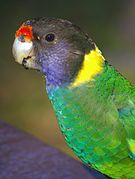
Identification: The red band and green belly distinguishes it from the Port Lincoln Parrot. Found in the south western forests of coastal and subcoastal Western Australia.[10] B. z. semitorquatus
(Quoy & Gaimard, 1830)Port Lincoln Parrot or
Port Lincoln RingneckCommon from Port Lincoln in the south east to Alice Springs in the north east, and from the Karri and Tingle forests of South Western Australia up to the Pilbara district.[11] B. z. zonarius
(Shaw, 1805)Cloncurry Parrot 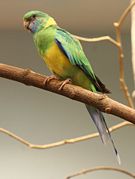
Identification: The yellow belly, lighter green colour and lack of red band distinguishes it from the Mallee Ringneck. Found from the Lake Eyre basin in the Northern Territory to the Gulf Country of northwestern Queensland, from Burketown south to Boulia, with Kynuna and Camooweel as eastern and western limits respectively.[12] B. z. macgillivrayi
(North, 1900)Mallee Ringneck 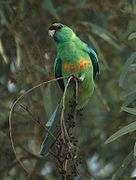
Inhabits central and western New South Wales west of Dubbo, the southwestern corner Queensland west of St George, eastern South Australia and northwestern Victoria.[13] B. z. barnardi
(Vigors & Horsfield, 1827)Behaviour
The Australian Ringneck is active during the day and can be found in eucalypt woodlands and eucalypt-lined watercourses. The species is gregarious and depending on the conditions can be resident or nomadic. In trials of growing hybrid eucalypt trees in dry environments parrots, especially the Port Lincoln Parrot, caused severe damage to the crowns of the younger trees during the research period between 2000–3.[14]
Feeding
This species eats a wide range of foods that include nectar, insects, seeds, fruit, and native and introduced bulbs. It will eat orchard-grown fruit and is sometimes seen as a pest by farmers.[2][15]
Breeding
Breeding season for the Northern populations starts in June or July, while the central and southern populations breed from August to February, but this can be delayed when climatic conditions are unfavourable. The nesting site is a hollow in a tree trunk.[16] Generally four or five white oval eggs are laid measuring 29 mm x 23 mm, although a clutch may be as few as three and as many as six.[17] Fledgling survival rates have been measured at 75%.[18]
Conservation
Although the species is endemic,[19] the species is considered not threatened,[1] but in Western Australia, the Twenty-eight subspecies (B. z. semitorquatus) gets locally displaced by the introduced Rainbow Lorikeets that aggressively compete for nesting places.[20] The Rainbow Lorikeet is considered a pest species in Western Australia and is subject to eradication in the wild.[21]
In Western Australia, a license is required to keep or dispose of more than four Port Lincoln Ringnecks.[22] All four subspecies are sold in the Canary Islands and in Australia,[22] and they are traded via the CITES convention.[23] The sale of the Cloncurry Parrot is restricted in Queensland.[24] The Australian Ringneck can suffer from Psittacine Beak and Feather Disease, which causes a high nestling mortality rate in captivity.[25]
References
- ^ a b BirdLife International (2004). Barnardius zonarius. 2006. IUCN Red List of Threatened Species. IUCN 2006. www.iucnredlist.org. Retrieved on 11 May 2006.
- ^ a b c Forshaw, Joseph M.; Cooper, William T. (1981) [1973, 1978]. Parrots of the World (corrected second ed.). David & Charles, Newton Abbot, London. ISBN 0-7153-7698-5.
- ^ Christidis, L. & Boles, W.E. (1994). The Taxonomy and Species of Birds of Australia and its Territories. Hawthorn East, Victoria : Royal Ornithologists Union Monograph Vol. 2 112 pp.
- ^ a b c d Joseph, L. & Wilke, T. 2006. Molecular resolution of population history, systematics and historical biogeography of the Australian ringneck parrots Barnardius: are we there yet? Emu 106: 49-62
- ^ a b c d e Field Guide to the Birds of Australia - A book of identification Simpson and Day, (1993) pp.144 ISBN 0-670-90670-0
- ^ "Bauer, Ferdinand, 1760-1826 - natural history drawings". National Library of Australia. http://www.nla.gov.au/pict/list/bauer.html.
- ^ "Barnardius zonarius (Shaw, 1805)". Australian Biological Resources Study:. http://www.environment.gov.au/cgi-bin/abrs/fauna/details.pl?pstrVol=AVES&pstrTaxa=1169&pstrChecklistMode=2. Retrieved 2007-11-07.
- ^ Schodde, R. & Mason, I.J. (1997) Aves (Columbidae to Coraciidae). In, Houston, W.W.K. & Wells, A. (eds) Zoological Catalogue of Australia. Melbourne: CSIRO Publishing, Australia Vol. 37.2 xiii 440 pp.
- ^ a b Ford, J. (1987). "Hybrid zones in Australian birds". Emu 87 (3): 158–178. doi:10.1071/MU9870158. http://www.publish.csiro.au/nid/96/paper/MU9870158.htm.
- ^ Lendon, p. 166
- ^ Lendon, p. 161
- ^ Lendon, p. 157
- ^ Lendon, p. 152-52
- ^ Barbour, E.L. (2004). "Eucalypt hybrids in south-west Western Australia". RIRDC, Australian government. Archived from the original on 5 October 2007. http://web.archive.org/web/20071005132142/http://www.rirdc.gov.au/reports/AFT/04-021sum.html. Retrieved 2008-08-02.
- ^ "Parrot damage in agroforestry in the greater than 450 mm rainfall zone of Western Australia". Department of Agriculture and Food, Western Australia. http://www.agric.wa.gov.au/content/LWE/VEGT/TREES/TREENOTE26.htm. Retrieved 2007-11-07.
- ^ "Australian Ringneck". birdsinbackyards.net. Australian Museum. http://www.birdsinbackyards.net/finder/display.cfm?id=362.
- ^ Beruldsen, G (2003). Australian Birds: Their Nests and Eggs. Kenmore Hills, Qld: self. p. 247. ISBN 0-646-42798-9.
- ^ "Australian Ringneck". Fauna Note No. 22. Department of Agriculture and Food, Western Australia. http://www.agric.wa.gov.au/content/pw/vp/bird/22_australian_ringneck.pdf. Retrieved 2008-08-02.
- ^ Martin, Stella (2002). "Birds of the savannas". Tropical Topics (Environmental Protection Agency Northern Division) 73. http://www.epa.qld.gov.au/register/p00820af.pdf. Retrieved 2008-07-23.
- ^ Chapman, Tamra (2005). "The status and impact of the Rainbow Lorikeet (Trichoglossus haematodus moluccanus) in South-West Western Australia". Wildlife Branch, Department of Conservation and Land Management. http://www.agric.wa.gov.au/pls/portal30/docs/FOLDER/IKMP/PW/VP/BIRD/LORIKEETMISCPUB.PDF. Retrieved 2007-11-08.
- ^ Massam, Marion (2007). "Rainbow lorikeet management options". Department of Agriculture and Food. http://www.agric.wa.gov.au/content/pw/vp/bird/pn2006_rainbcontrol_mmassam.pdf. Retrieved 2007-11-07.
- ^ a b "Sustainable Economic Use of Native Australian Birds and Reptiles". RIRDC, Australian government. February 1997. Archived from the original on 26 October 2007. http://web.archive.org/web/20071026230921/http://www.rirdc.gov.au/reports/NAP/97-26.pdf. Retrieved 2008-08-02.
- ^ "CITES Digest". November 2002. http://www.ssn.org/Meetings/cop/cop12/Proposals/SNNDigest_SP12_EN.pdf. Retrieved 2008-08-02.
- ^ "NATURE CONSERVATION LEGISLATION AMENDMENT REGULATION (No. 2)". Queensland, Australia. 1997. http://www.legislation.qld.gov.au/LEGISLTN/SLS/1997/97SL436.pdf.
- ^ "Environment Protection and Biodiversity Conservation Act, Section 270B, Making of Threat Abatement Plans". Commonwealth of Australia. 1999. http://fedlaw.gov.au/ComLaw/Legislation/LegislativeInstrument1.nsf/framelodgmentattachments/81FCCCA0AB589760CA25718E00044623.
Cited text
- Lendon, Alan H. (1973). Australian Parrots in Field and Aviary (2nd. ed). Sydney: Angus and Robertson. ISBN 0-207-12424-8.
Further reading
Listen to this article (info/dl)
This audio file was created from a revision of Australian Ringneck dated 2007-05-13, and does not reflect subsequent edits to the article. (Audio help)More spoken articles- The Atlas of Australian Birds, Blakers, Davies & Reilly, (1984) ISBN 0-522-84285-2
- Photographic Field Guide to Birds of Australia, Jim Flegg, (2002) ISBN 1-876334-78-9
- John Gould's The Birds of Australia :
- Full text available from National Library of Australia in an electronic format at http://nla.gov.au/nla.aus-f4773
- B. z. semitorquatus plate
Categories:- IUCN Red List least concern species
- Broad-tailed parrots
- Platycercini
- Birds of South Australia
- Birds of Western Australia
- Monotypic bird genera
- Birds kept as pets
- Animals described in 1805
Wikimedia Foundation. 2010.


